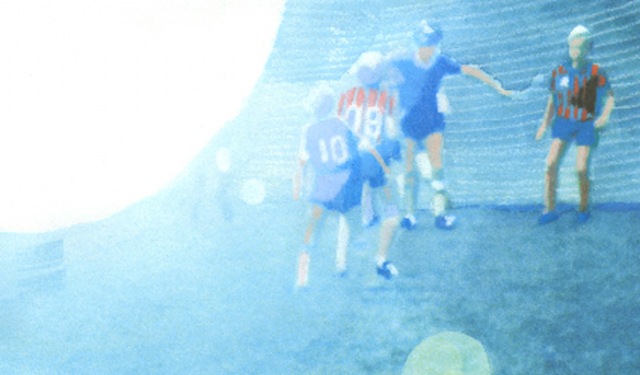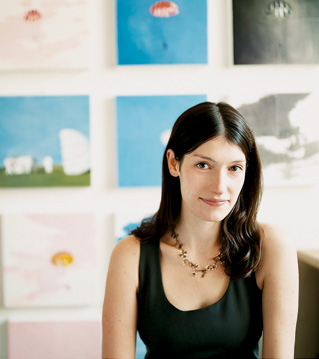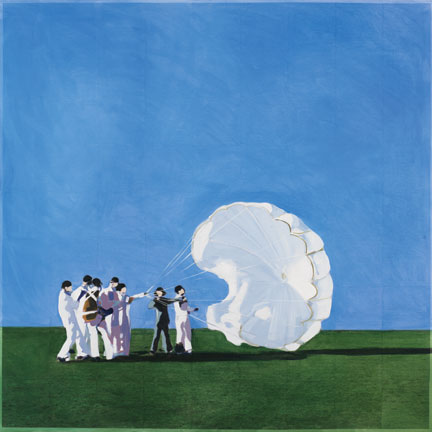
Isca Greenfield-Sanders
Interview: Isca Greenfield-Sanders
Isca Greenfield-Sanders: Light Leaks will be presented in the David & Laura Merage Foundation Gallery at the Museum of Contemporary Art Denver from Oct. 15, 2010, through Jan. 16, 2011.

Isca Greenfield-Sanders
New York painter Isca Greenfield-Sanders was presenting solo shows as a college undergrad, sold a painting to the Guggenheim and was profiled in Vogue – all by 25. But when the Museum of Contemporary Art Denver came knocking, a unique opportunity lay in front of her: creating a body of new work for her first-ever solo museum exhibit. Opening Oct. 15, “Light Leaks” is a series of mixed-media paintings originating from found 1960s photographs, flaws intact.
An interview with the artist:
Greenfield-Sanders, who turned 32 on Oct. 6, spoke to AdobeAirstream from her home in New York City.
Isca is an interesting name. Where did it come from?
Its my Norwegian grandmothers name, and her grandmothers, and her grandmothers… Im the fourth Isca.
Tell us about how this – your first solo museum exhibition – came about.
It came about in a twofold way – the [Denver MCAs] newly hired curator, Nora Burnett Abrams, was a passing ship in the night for me. We have mutual friends, and she had known of my work over the years. She started working in Denver, and my dealer, Robert Goff, had been introducing my work to the director of the museum, Adam [Lerner]. They approached me about making a body of new work for the museum, which was particularly exciting.
How so?
Typically, you show work youve made to date as opposed to a brand new show. And of course, David Adjayes building is so beautiful; theyve chosen one of the large galleries downstairs. Ive yet to see the museum in person.

Lens Flare (Soccer), 2010 63 x 63 in.; Mixed media oil on canvas.
You double-majored in, of all things, math and painting. Talk about the technique you employ in your work.
Its a layered process that incorporates watercolor, colored pencil, photography and oil. I begin with vintage photographs from the 1960s, and I make prints of those photographs – or sections of those photographs – on canvas with watercolor or colored pencil. I scan that in, in tiles, print it on rice paper, glue the tiles to the surface of the canvas, then paint an oil on top. So what youre looking at is an oil painting that is an enlargement of a watercolor that was originally a small watercolor that was originally a photograph.
In your “Light Leaks” series youve preserved the original images flaws in the final works, at times introducing them yourself. What was your thought process there?
I was looking at the series as a whole, so I had some images that had flares and some with double exposures. I wanted to attempt to reproduce the problems that came up in the realm of a film photographer. I also paid close attention to treatment of figures within the composition in reference to the other objects. In the soccer images, theres no horizon line. The figures occupy a forced space in terms of not having the relief of the sky above them. The palette became paired down to very few core group of colors. The net became important to me as opposed to the figures. I dont think there is a ball in any of them. Sometimes its important to recognize what isnt there as opposed to what is. [These paintings] speak to images taken in sequence. When you were confined with 24 and 36 exposures, you kept everything because you were confined to a certain number of images. Today you can still take a blurry photo with a digital camera, but youre less likely to keep it.
The bulk of your paintings are based off found photographs from the 1960s. What draws you about that decade?
My interest in that period is, in large part, formal: There is a wonderful lack of logo-ing on peoples T-shirts and a certain amount of visual garbage inevitably captured in contemporary landscape. I also think the way people were photographing one another in the 60s was appealing. Early film cameras did not do well indoors. And in terms of my painting agenda, I love to do landscapes.
Where do you find them, and what are you looking for?
Im looking for images that recall motifs from art history, although inadvertently to the photographer who shot them. I never know who took them. I buy them on eBay, at garage sales and flea markets. Typically they are unlabeled, and occasionally there is a hand-written indication of who is in the photograph. [Light Leaks] soccer images recall Degás “A Day at the Races” for me – figures in motion in highly bright, new form.

Parachute Class I, 2008 Mixed Media Oil on Canvas 63 x 63 inches
What are your fondest childhood memories – Im thinking most specifically of your father [photographer Timothy Greenfield-Sanders] – of growing up in an artistic family?
My parents house is filled with contemporary art, and they are close with a lot of the artists who made those works. I was lucky enough to not only know the people and their work, but know what it was to have art be your guiding practice and your vocation.
So what is it like?
I think its very difficult for people to imagine an artists life. Its depicted in such a phony way by Hollywood and literature. I dont have these tortured, all-night sessions where Im smoking and working with a single, bare lightbulb flashing on a painting [laughs].
A lot of misperceptions, then, about how you fill your days and nights.
Right. At one point my husbands mother, with whom Im very close, started buying us gifts youd buy for a newly married couple, though we werent yet married. Ill always remember she said, “Well, you guys are artist types – are you really going to go through with actually getting married?”
Your husband [artist and musician Sebastian Blanck] is also a painter, and you appear in many of his paintings. Which is your favorite?
Hes done so many beautiful portraits of me. Im looking at two of them as were talking – its like choosing your favorite children or something. In one, Im walking up the stairs and holding our older son in my arms – it captures our daily life in such a beautiful way. He has included my artwork in his portraits of me working in the studio – we work side by side, separated by a wall, so we are together all day long. Its always so interesting to see my paintings shorthanded by his elaborate, collage technique.
Speaking of your husband, a painting from your parachute series (circa 2008) appears on the cover of his new album, and designer Adam Lippes said another of that series inspired his fall 2010 collection. One also graced the cover of Italian Vogue, and another was purchased by the The Israel Museum in Jerusalem. What do you make of all that?
For me theres a strong connection between the disparate bodies of work, but the parachutes stood farther apart – I incorporated gold leaf and painted all black for the first time. You correctly point out there were a lot of outlets these paintings lent themselves to. Having spent a short time in graphic design, I recognize that these – with their small figures, big landscapes and open color fields – lend themselves to that.
Tell me about finding the parachute photographs and beginning the series.
Well, we were at war, and I had found six Korean War-era images on 35mm slides of single parachuters falling through the air. And I came across the phrase “golden parachute,” which is instantly attractive to that artist who deals in colors. The red-and-white-striped parachutes looked like Wayne Thiebaud to me – like beautiful little candy drops. There was something about the odd juxtaposition about the way they looked that was a starting point. The French word for parachute translates to “against the fall,” which worked – because when youre at war, youre against something, right? Its these very small, nebulous feelings Im trying to pull out for people in paint.
Have you ever jumped out of an airplane or otherwise been in a parachute?
My God, no. Remember? Very normal daily life.
What hobbies do you have that have nothing to do with art?
I love to watch TV – I know thats a silly answer. I like to swim. Most of my time in the last three years has been devoted to my children (ages 3 and 10 months). We build a lot of forts and mazes, and talk a lot about Halloween costumes.
“Isca Greenfield-Sanders: Light Leaks” will be presented in the David & Laura Merage Foundation Gallery at the Museum of Contemporary Art Denver from Oct. 15, 2010 (paired with an opening celebration), through Jan. 16, 2011.
